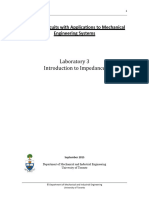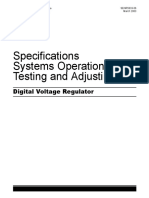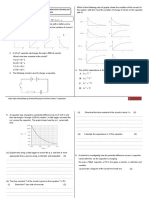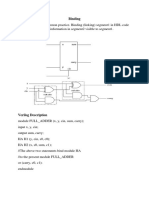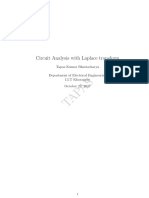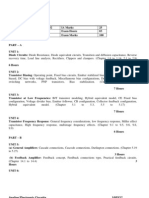0 ratings0% found this document useful (0 votes)
131 viewsB.SC (ECS) 14ECU01 Principles of Electronics: Programme Course Code Title
B.SC (ECS) 14ECU01 Principles of Electronics: Programme Course Code Title
Uploaded by
veeramaniks408This document outlines the objectives, inputs, units, and expected level of output for an electronics and communication systems course on principles of electronics. The course aims to impart fundamental knowledge of passive and active components, AC and DC circuits, and network theorems. It is intended to provide a conceptual level understanding. The course is divided into 5 units covering topics such as passive circuit components, AC/DC circuits fundamentals, network theorems, semiconductor devices, and FETs and thyristors. It will include 55 hours of instruction with 80% devoted to theory and 20% to problem solving. Students will be evaluated through continuous internal assessments and an end semester exam.
Copyright:
© All Rights Reserved
Available Formats
Download as DOCX, PDF, TXT or read online from Scribd
B.SC (ECS) 14ECU01 Principles of Electronics: Programme Course Code Title
B.SC (ECS) 14ECU01 Principles of Electronics: Programme Course Code Title
Uploaded by
veeramaniks4080 ratings0% found this document useful (0 votes)
131 views2 pagesThis document outlines the objectives, inputs, units, and expected level of output for an electronics and communication systems course on principles of electronics. The course aims to impart fundamental knowledge of passive and active components, AC and DC circuits, and network theorems. It is intended to provide a conceptual level understanding. The course is divided into 5 units covering topics such as passive circuit components, AC/DC circuits fundamentals, network theorems, semiconductor devices, and FETs and thyristors. It will include 55 hours of instruction with 80% devoted to theory and 20% to problem solving. Students will be evaluated through continuous internal assessments and an end semester exam.
Original Description:
Syllabus
Original Title
Principles of Electronics
Copyright
© © All Rights Reserved
Available Formats
DOCX, PDF, TXT or read online from Scribd
Share this document
Did you find this document useful?
Is this content inappropriate?
This document outlines the objectives, inputs, units, and expected level of output for an electronics and communication systems course on principles of electronics. The course aims to impart fundamental knowledge of passive and active components, AC and DC circuits, and network theorems. It is intended to provide a conceptual level understanding. The course is divided into 5 units covering topics such as passive circuit components, AC/DC circuits fundamentals, network theorems, semiconductor devices, and FETs and thyristors. It will include 55 hours of instruction with 80% devoted to theory and 20% to problem solving. Students will be evaluated through continuous internal assessments and an end semester exam.
Copyright:
© All Rights Reserved
Available Formats
Download as DOCX, PDF, TXT or read online from Scribd
Download as docx, pdf, or txt
0 ratings0% found this document useful (0 votes)
131 views2 pagesB.SC (ECS) 14ECU01 Principles of Electronics: Programme Course Code Title
B.SC (ECS) 14ECU01 Principles of Electronics: Programme Course Code Title
Uploaded by
veeramaniks408This document outlines the objectives, inputs, units, and expected level of output for an electronics and communication systems course on principles of electronics. The course aims to impart fundamental knowledge of passive and active components, AC and DC circuits, and network theorems. It is intended to provide a conceptual level understanding. The course is divided into 5 units covering topics such as passive circuit components, AC/DC circuits fundamentals, network theorems, semiconductor devices, and FETs and thyristors. It will include 55 hours of instruction with 80% devoted to theory and 20% to problem solving. Students will be evaluated through continuous internal assessments and an end semester exam.
Copyright:
© All Rights Reserved
Available Formats
Download as DOCX, PDF, TXT or read online from Scribd
Download as docx, pdf, or txt
You are on page 1of 2
Course Objective : To impart fundamental knowledge on Passive and Active components,
AC and DC circuits, and Network Theorems.
Expected Level of Output : Conceptual Level
Department offered : Electronics and Communication Systems
Course Inputs :
Unit Description
Text
Book
Chapter
Instructional
Hours
I
Passive Circuit Components
Resistors
Fixed resistor; Variable resistor; Colour coding;
Tolerance
B 2 2
Series and parallel connection B 2 1
Capacitors
Basic structure and symbol; Fixed capacitors; Variable
capacitors; Dissipation Factor
A 7 2
Series and Parallel Connection A 7 1
Inductors
Inductance of the coil; Fixed inductors; Variable
inductors; Inductive reactance; Energy stored in an
inductor; Q factor
A 7 3
Mutual Inductance; Series and Parallel Connection A 7 2
II
AC and DC Circuits Fundamentals
Alternating current; Peak value; Average value; RMS
value; Frequency; Time period
A 6 1
Wave length; Phase angle; Three phase AC Power; AC
circuits with resistance
B 16 2
AC circuits with X
L
; AC circuits with X
C
; Series
reactance and resistance; Parallel reactance and
resistance
B 24 2
Series Parallel reactance and resistance; Real power;
Apparent power
B 24 1
Series resonance circuit; Parallel resonance circuit B 26 1
Ohms law; Kirchhoffs law B 3&9 1
Analysis of Series circuit; Parallel circuits and Series
Parallel circuits
B 4,5&6 2
Voltage divider; Current divider; Simple problems in
DC circuits
B 7 2
Programme Course Code Title
B.Sc (ECS) 14ECU01 Principles of Electronics
III
Network Theorem
Superposition theorem; Thevenins theorem
B 10 2
Thevenzing a circuit with two Voltage Source;
Thevenzing a Bridge circuits
B 10 2
Norton theorem; Thevenins Norton conversion B 10 2
Conversion of voltage and current source; Millmans
theorem
B 10 2
Maximum power transfer theorem; Simple problems in
DC circuits
A&B 5,10 2
IV
Semiconductor Devices
Conductor; Semiconductor; Intrinsic Semiconductor;
Extrinsic semiconductor
A 10 2
P type and N type Semiconductor A 10 1
PN junction diode; V-I characteristics; Applications A 12 1
Zener diode; V-I characteristics; Zener diode
Applications
A 13 1
Construction of NPN, PNP transistors A 14 1
Operation of NPN, PNP transistors A 14 1
Characteristics of CE and CB Transistor configurations A 14 2
V
FET and Thyristors
JFET: Construction, Operation and Characteristics;
Comparison between FET and BJT
A 16 2
MOSFET: Types; construction, Working and
Characteristics
A 16 2
SCR: Construction, Operation and V-I characteristics;
Applications
A 17 1
TRIAC: Construction, Operation and V-I characteristics;
Applications
A 17 1
UJT: Construction, Operation and V-I characteristics;
Applications
A 17 1
DIAC: Construction and V-I characteristics A 17 1
Revision
5
Total Hours 55
Note: 80% Theory; 20% Problems
CIA 25 marks; End Semester: 75 marks
Text Books:
A. R.S.Sedha, A Text Book of Applied Electronics, S.Chand and Company Ltd., 2010.
B. Bernard Grob, Basic Electronics, Tata McGraw Hill, Ninth Edition 2003.
Reference Books:
A. V.K. Mehta, Rohit Mehta, Principles of Electronics, S.Chand and Company Ltd., 2005.
B. Malvino, Albert Paul, Electronic Principles, Tata McGraw Hill, Sixth Edition 2004.
You might also like
- UofT - MIE342 - Lab 3 ImpedanceDocument36 pagesUofT - MIE342 - Lab 3 ImpedanceVarun ParikhNo ratings yet
- DVR Manual Senr5833-06Document68 pagesDVR Manual Senr5833-06Sayed Younis Sadaat75% (4)
- Dragon City Complete Dragon Breeding GuideDocument7 pagesDragon City Complete Dragon Breeding Guidesukhber75% (8)
- Question Paper 8051 Microcontroller and ApplicationsDocument1 pageQuestion Paper 8051 Microcontroller and Applicationsveeramaniks408100% (1)
- Cinepro 4 6: Owners ManualDocument9 pagesCinepro 4 6: Owners Manualcelgui3No ratings yet
- Cheat Sheet Biomedical Instrumentation ExamDocument1 pageCheat Sheet Biomedical Instrumentation Examdeemz00% (1)
- Low Capacitance TVS For LVDS Interfaces: Protection Products - Railclamp Description FeaturesDocument8 pagesLow Capacitance TVS For LVDS Interfaces: Protection Products - Railclamp Description FeaturesAnibal Tantalean SarmientoNo ratings yet
- Engineering Physics - G. AruldhasDocument99 pagesEngineering Physics - G. Aruldhassubho0% (1)
- Notes On Diffy Q's Jiri Lebl PDFDocument466 pagesNotes On Diffy Q's Jiri Lebl PDFJulio HernandezNo ratings yet
- Engineering MathmaticsDocument40 pagesEngineering Mathmaticsali,r98No ratings yet
- Applied Physics - M. ArumugamDocument71 pagesApplied Physics - M. ArumugamAditi NarendranNo ratings yet
- Basic Calculus RefresherDocument22 pagesBasic Calculus RefresherFernando Lipardo Jr.No ratings yet
- Vector Calculus R16Document87 pagesVector Calculus R16Meghna SahaNo ratings yet
- Atomic PhysicsDocument58 pagesAtomic PhysicsBasitNo ratings yet
- Statistical Mechanics Python CodeDocument48 pagesStatistical Mechanics Python CodeJeet BhattacharjeeNo ratings yet
- RC CircuitsDocument6 pagesRC CircuitsSusan KNo ratings yet
- Module 3 - Ckt-Expr Analysis-Sop-PosDocument35 pagesModule 3 - Ckt-Expr Analysis-Sop-PosMain axieinfinityNo ratings yet
- Solutions Manual For Fluid Mechanics 5th PDFDocument20 pagesSolutions Manual For Fluid Mechanics 5th PDFchala nigussieNo ratings yet
- Math1 Tutorial5Document2 pagesMath1 Tutorial5KarthikRaoNo ratings yet
- Phys.303-Classical Mechanics Ii - Lectur PDFDocument184 pagesPhys.303-Classical Mechanics Ii - Lectur PDFZaviraNabillaNo ratings yet
- Fourier Series With ProblemsDocument30 pagesFourier Series With ProblemsAnuraj N VNo ratings yet
- Just The Maths - A.J.hobson (Complex Numbers)Document47 pagesJust The Maths - A.J.hobson (Complex Numbers)Kriss_PsNo ratings yet
- Resistance, Reactance & ImpedanceDocument29 pagesResistance, Reactance & ImpedanceMarysun TlengrNo ratings yet
- Homing GuidanceDocument5 pagesHoming Guidancebalweg mackyNo ratings yet
- Electromagnetic Wave Propagation (II)Document21 pagesElectromagnetic Wave Propagation (II)vasanthi_thiyagarajaNo ratings yet
- Cplus FaqDocument287 pagesCplus FaqGangadhar Reddy TavvaNo ratings yet
- Initial LIGODocument25 pagesInitial LIGORobin100% (1)
- Differential Equations SummaryDocument3 pagesDifferential Equations SummaryFaisal RaoNo ratings yet
- List of Scilab CodesDocument68 pagesList of Scilab CodesOscar Sttewe Jaehnig BarriosNo ratings yet
- Btech 2 Sem Engineering Physics Kas201t 2022Document2 pagesBtech 2 Sem Engineering Physics Kas201t 2022Neelam SinghNo ratings yet
- IT.pdf شرح المنهج عربيDocument163 pagesIT.pdf شرح المنهج عربيMohammed DahkemNo ratings yet
- Chemical Mystery 1Document3 pagesChemical Mystery 1Keirby CayanongNo ratings yet
- Module 1 Basic Electrical TheoryDocument166 pagesModule 1 Basic Electrical TheorymayelewoNo ratings yet
- Calculus of Parametric EquationsDocument13 pagesCalculus of Parametric EquationsTwevleNo ratings yet
- 6.-Encyclopedia of Electrochemistry. Semiconductor Electrodes and Photoelectrochemistry Vol 6Document563 pages6.-Encyclopedia of Electrochemistry. Semiconductor Electrodes and Photoelectrochemistry Vol 6Yanpiero BalladoresNo ratings yet
- Capacitors Revision Worksheet: Addu High School Hithadhoo/AdduDocument8 pagesCapacitors Revision Worksheet: Addu High School Hithadhoo/AdduDhan Bahadhur Mr.Dhan Bahadur BoharaNo ratings yet
- D Flip-Flop Using 6 NAND GatesDocument3 pagesD Flip-Flop Using 6 NAND GatesAsadullah JamalovNo ratings yet
- Eris 01 IntroductionToRadio1Document29 pagesEris 01 IntroductionToRadio1Anggoro Adi SuciptoNo ratings yet
- 3D Mesh Generation PDFDocument21 pages3D Mesh Generation PDFSahil KalaNo ratings yet
- 9.nuclear and Particle Physics - NET-JRFDocument20 pages9.nuclear and Particle Physics - NET-JRFPronay DuttaNo ratings yet
- DSD Notes Unit 2 PDFDocument18 pagesDSD Notes Unit 2 PDFVAISHAKA N RAJNo ratings yet
- Industry 4.0 in Manufacturing: ME F426 (I SEM, 2020-2021) byDocument17 pagesIndustry 4.0 in Manufacturing: ME F426 (I SEM, 2020-2021) byakash chNo ratings yet
- Vector CalculusDocument158 pagesVector CalculusTuan JalaiNo ratings yet
- Basic Electronic ComponentsDocument84 pagesBasic Electronic ComponentsAj RaynaNo ratings yet
- CH 1-Ch 7Document13 pagesCH 1-Ch 7Eligius MartinezNo ratings yet
- Thermodynamics 2Document22 pagesThermodynamics 2Gowri ShankarNo ratings yet
- Unit 1 Circuits and Networks: StructureDocument21 pagesUnit 1 Circuits and Networks: StructureMomoko SakuraNo ratings yet
- 5 Fault AnalysisDocument45 pages5 Fault AnalysisSari M.INo ratings yet
- Problem Class Questions For PHY008 Atomic and Nuclear PhysicsDocument14 pagesProblem Class Questions For PHY008 Atomic and Nuclear Physicstsania nkdNo ratings yet
- GATE Electrical by Kanodia PDF 1 200Document200 pagesGATE Electrical by Kanodia PDF 1 200Ankita Sogani Kothari100% (1)
- Circuit Analysis With Laplace Transform (Week 6) PDFDocument7 pagesCircuit Analysis With Laplace Transform (Week 6) PDFmaaz ansariNo ratings yet
- 10Document12 pages10Julio Velez0% (1)
- Nuclear Physics and Reactor Theory Vol 1 and 2Document245 pagesNuclear Physics and Reactor Theory Vol 1 and 2kollliNo ratings yet
- EE552 Power Electronics Project ReportDocument17 pagesEE552 Power Electronics Project ReportMashood NasirNo ratings yet
- Combined Stresses Worked Problems OCRDocument15 pagesCombined Stresses Worked Problems OCRAnonymous uN2lxBNo ratings yet
- Syllabus For BSC GeneralDocument9 pagesSyllabus For BSC GeneralSudikin PramanikNo ratings yet
- BEE Syllabus 2024schemefinalDocument3 pagesBEE Syllabus 2024schemefinalAmogh K VNo ratings yet
- Course Outline MengnewDocument2 pagesCourse Outline Mengneweliastadele7No ratings yet
- Ece-III-Analog Electronic Ckts (10es32) - NotesDocument238 pagesEce-III-Analog Electronic Ckts (10es32) - NotesShubhesh SwainNo ratings yet
- ELECTRONICSDocument9 pagesELECTRONICSSankalp KashyapNo ratings yet
- Basic electronics-Co-Po-Syllabus-Lesson PlanDocument8 pagesBasic electronics-Co-Po-Syllabus-Lesson PlanSantana DasNo ratings yet
- Designing Using Gimp SyllabusDocument2 pagesDesigning Using Gimp Syllabusveeramaniks408No ratings yet
- TNSCST-SPS August 2023 - CoverDocument1 pageTNSCST-SPS August 2023 - Coverveeramaniks408No ratings yet
- Designing Using GimpDocument2 pagesDesigning Using Gimpveeramaniks408No ratings yet
- VB MCQ 1Document2 pagesVB MCQ 1veeramaniks408No ratings yet
- Geogebra SyllabusDocument2 pagesGeogebra Syllabusveeramaniks408No ratings yet
- Electric Drives and ControlDocument1 pageElectric Drives and Controlveeramaniks408No ratings yet
- Section - A Answer All Questions (10 X 1 10 Marks)Document1 pageSection - A Answer All Questions (10 X 1 10 Marks)veeramaniks408No ratings yet
- PIC18F4550 Pin FunctionsDocument2 pagesPIC18F4550 Pin Functionsveeramaniks408No ratings yet
- Question Paper Robotics and Arduino ProgrammingDocument1 pageQuestion Paper Robotics and Arduino Programmingveeramaniks408100% (1)
- Priniciples of Embedded SystemsDocument2 pagesPriniciples of Embedded Systemsveeramaniks408No ratings yet
- Power Sytem AnalysisDocument1 pagePower Sytem Analysisveeramaniks408No ratings yet
- Microprocessor and ControllersDocument1 pageMicroprocessor and Controllersveeramaniks408No ratings yet
- Analog and Digital ElectronicsDocument1 pageAnalog and Digital Electronicsveeramaniks408No ratings yet
- Digital Signal ProcessingDocument1 pageDigital Signal Processingveeramaniks408No ratings yet
- Turbidity SensorDocument2 pagesTurbidity Sensorveeramaniks408No ratings yet
- Electronic Communication SystemsDocument1 pageElectronic Communication Systemsveeramaniks408No ratings yet
- Question Bank - MicrowaveDocument4 pagesQuestion Bank - Microwaveveeramaniks408No ratings yet
- Embedded System Design Unit - I Embedded Systems OverviewDocument1 pageEmbedded System Design Unit - I Embedded Systems Overviewveeramaniks408No ratings yet
- DSP QuestionsDocument2 pagesDSP Questionsveeramaniks408No ratings yet
- Programmable Peripheral Interface 8255: Microprocessor Unit 4 1Document32 pagesProgrammable Peripheral Interface 8255: Microprocessor Unit 4 1veeramaniks408No ratings yet
- Industrial Networking: Industrial Communication Network Is A Special Type of Network Made To Handle Real-TimeDocument1 pageIndustrial Networking: Industrial Communication Network Is A Special Type of Network Made To Handle Real-Timeveeramaniks408No ratings yet
- Asic - QPDocument2 pagesAsic - QPveeramaniks408No ratings yet
- Direct Computation 2. Radix-2 FFT 3. Decimation-In-Time FFT 4. Flowgraphs 5. Bit Reversal Permutation 6. Complexity 7. Decimation-In-Frequency FFTDocument26 pagesDirect Computation 2. Radix-2 FFT 3. Decimation-In-Time FFT 4. Flowgraphs 5. Bit Reversal Permutation 6. Complexity 7. Decimation-In-Frequency FFTveeramaniks408No ratings yet
- PIC Real Time Clock DS1307: Analogue Keys Multiplexed 7seg Display IcspDocument1 pagePIC Real Time Clock DS1307: Analogue Keys Multiplexed 7seg Display Icspveeramaniks408100% (1)
- Raspberry Pi LESSON 32: Analog Input For The Raspberry PiDocument4 pagesRaspberry Pi LESSON 32: Analog Input For The Raspberry Piveeramaniks408No ratings yet
- Transfer Switch Controller CEC6.2 - Ing PDFDocument12 pagesTransfer Switch Controller CEC6.2 - Ing PDFRoberto MerizaldeNo ratings yet
- DS HZM AUS SITEC Xtend CGC-TGC Digital-Generator-Control eDocument4 pagesDS HZM AUS SITEC Xtend CGC-TGC Digital-Generator-Control eMohammed Thofeek KhanNo ratings yet
- R23 Beee Mid QBDocument7 pagesR23 Beee Mid QBmaneeshgopisettyNo ratings yet
- Area Controller For Steady State Voltage Management in Large Scale Wind FarmDocument5 pagesArea Controller For Steady State Voltage Management in Large Scale Wind FarmNguyen Van ToanNo ratings yet
- Design Guidelines of Circuit Parameters For Modular Multilevel Converter With H-Bridge CellDocument14 pagesDesign Guidelines of Circuit Parameters For Modular Multilevel Converter With H-Bridge Cellp09el860No ratings yet
- Analysis of Electricity Network Capacities and Con 595d15d31723dd8c40a99992Document153 pagesAnalysis of Electricity Network Capacities and Con 595d15d31723dd8c40a99992Mustafa DemirolNo ratings yet
- Intelligent Metering and Control Devices: Applications Summary Features SummaryDocument8 pagesIntelligent Metering and Control Devices: Applications Summary Features SummaryFranz CabezasNo ratings yet
- Amps To Watts CalculatorDocument3 pagesAmps To Watts Calculatorcorc2014No ratings yet
- Optimized control strategy for a three-phase grid connected inverter using PI controller and DQ frameDocument8 pagesOptimized control strategy for a three-phase grid connected inverter using PI controller and DQ frameInternational Journal of Applied Power EngineeringNo ratings yet
- TS03 ING R0 - FMR Ts PDFDocument5 pagesTS03 ING R0 - FMR Ts PDFshekooferiahiNo ratings yet
- Power Quality Monitoring For Low Voltage Distribution SystemDocument32 pagesPower Quality Monitoring For Low Voltage Distribution SystemYahya Sheikh MussaNo ratings yet
- PIC18F87J72 Single-Phase Energy Meter Calibration User's GuideDocument63 pagesPIC18F87J72 Single-Phase Energy Meter Calibration User's Guidesonu sabooNo ratings yet
- Transmission Line Shunt and Series Compensation With Voltage Sensitive LoadsDocument18 pagesTransmission Line Shunt and Series Compensation With Voltage Sensitive LoadsHar Sha ChavaliNo ratings yet
- B.tech Information Technology SyllabusDocument52 pagesB.tech Information Technology Syllabussatishray15No ratings yet
- Power Quality Studies On A Soft-Start For An Induction MotorDocument6 pagesPower Quality Studies On A Soft-Start For An Induction MotorAl Bajad MamadNo ratings yet
- PQView Expanding Into Grid Operations PDFDocument60 pagesPQView Expanding Into Grid Operations PDFbdsrlNo ratings yet
- Saint Louis University School of Engineering and Architecture Department of Electronics EngineeringDocument6 pagesSaint Louis University School of Engineering and Architecture Department of Electronics EngineeringBeta TesterNo ratings yet
- V98XX Datasheet: Specifications Are Subject To Change Without NoticeDocument264 pagesV98XX Datasheet: Specifications Are Subject To Change Without Noticeعلی رستمیNo ratings yet
- EPE491 - Power in AC CircuitsDocument12 pagesEPE491 - Power in AC CircuitsNabill HpNo ratings yet
- Improvement of Power Quality Using Fuzzy Controlled D-Statcom in Distribution SystemDocument7 pagesImprovement of Power Quality Using Fuzzy Controlled D-Statcom in Distribution SystemIAES IJAINo ratings yet
- MCP39F511: Power-Monitoring IC With Calculation and Energy AccumulationDocument62 pagesMCP39F511: Power-Monitoring IC With Calculation and Energy AccumulationeyadNo ratings yet
- Investigation of The Impacts of Large-Scale Wind Power Penetration On The Angle and Voltage Stability of Power SystemsDocument10 pagesInvestigation of The Impacts of Large-Scale Wind Power Penetration On The Angle and Voltage Stability of Power SystemsbpchimeraNo ratings yet
- ECEN280 Spring 2020 Final 16May2020Document2 pagesECEN280 Spring 2020 Final 16May2020yazanqazzazNo ratings yet
- Elex RF PDFDocument40 pagesElex RF PDFKarumon UtsumiNo ratings yet
- MiCOM P543,544,545,546 Current Differential Protection RelayDocument193 pagesMiCOM P543,544,545,546 Current Differential Protection RelaySanjaya kumar SwainNo ratings yet
- Chapter 3 - Transformer - 0Document91 pagesChapter 3 - Transformer - 0blbmalekNo ratings yet
- ID Group ParameterDocument82 pagesID Group Parametergiapy0000No ratings yet
- III 1 Electrification 1 28Document30 pagesIII 1 Electrification 1 28Kevin LampaanNo ratings yet
- User Manual: HGM9560 Bus Tie Mains Parallel UnitDocument51 pagesUser Manual: HGM9560 Bus Tie Mains Parallel UnitArc HieNo ratings yet
